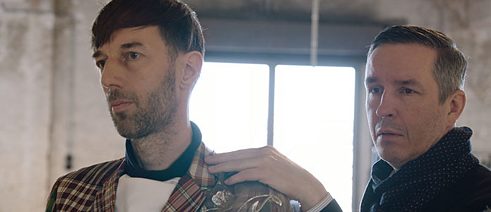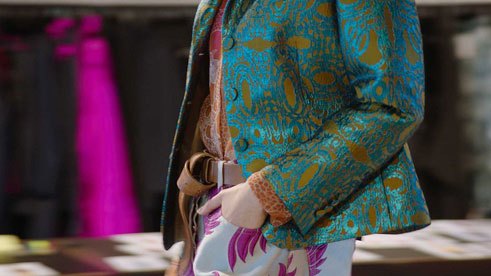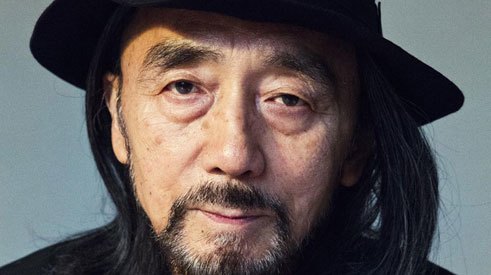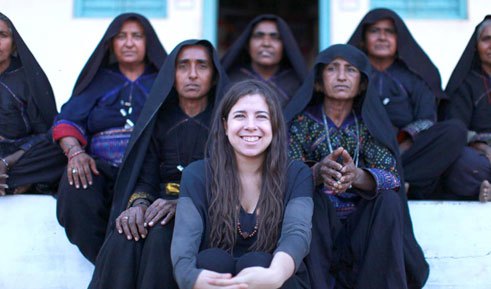ACMI’s Fashion on Film program
A genre of many threads: Fashion on film

When Dries Van Noten discusses his line of work, he offers a surprising admission. The Belgian designer isn’t fond of the term ‘fashion’ — “fashion means something that is over after six months. That’s what people consider fashion. I would like to find a word which is more timeless,” he explains. His revelation comes early in ‘Dries’, the documentary surveying his sartorial artistry as one of the world’s last independent visionaries, and encapsulates his penchant for bucking against convention. In addition, in providing an ostensible preface to a movie inescapably about fashion, it also brings the film sub-genre’s own status to mind.
Just as fashion, as a term, is synonymous with passing trends and crazes — aka something superficially alluring, but ultimately fleeting — factual explorations of fashion more frequently focus on the shiny surface of the industry. Documentaries about designers, such as Dries, abound, with the Reiner Holzemer-directed effort the latest in a long line of offerings concerned with the recognisable names and faces making, wearing or dictating the popularity of eye-catching outfits. Each film, be it a look at the life of a legendary pioneer (Valentino: The Last Emperor) or a journey through an influential magazine (The September Issue), unstitches its particular subject; however the sub-genre as a whole often thrusts brands, labels and well-known people into the cinematic spotlight. With its inclusion on the Australian Centre for the Moving Image’s (ACMI) 2017 Fashion on Film program, Dries forms part of a lineup that’s following in his footsteps: recognising the nature of the field, but also endeavouring to delve beyond the usual.
 The documentary 'Dries' (2017) is part of the 2017 Fashion on Film program of the Australian Centre for the Moving Image (ACMI)
| © ACMI
Dries itself hews close to its subject; where he goes, it follows over the course of four collections and one year. In his latest portrait of an artist after similar examinations of photographers August Sander, William Eggleston and Jürgen Teller, and photographer turned film director Anton Corbijn, Holzemer also lets Van Noten’s words echo throughout the film, relaying not only the designer’s thoughts on terminology, but on creativity. It’s an intimate effort, yet wide-ranging in its embrace of what makes its central figure stand out his peers. And while it doesn’t break the fashion documentary mould, it fascinates in its commitment to and chronicle of a man who does.
The documentary 'Dries' (2017) is part of the 2017 Fashion on Film program of the Australian Centre for the Moving Image (ACMI)
| © ACMI
Dries itself hews close to its subject; where he goes, it follows over the course of four collections and one year. In his latest portrait of an artist after similar examinations of photographers August Sander, William Eggleston and Jürgen Teller, and photographer turned film director Anton Corbijn, Holzemer also lets Van Noten’s words echo throughout the film, relaying not only the designer’s thoughts on terminology, but on creativity. It’s an intimate effort, yet wide-ranging in its embrace of what makes its central figure stand out his peers. And while it doesn’t break the fashion documentary mould, it fascinates in its commitment to and chronicle of a man who does.
With Yohji Yamamoto: Dressmaker, ACMI’s program also keeps intimate, though this is a documentary that expands that notion within the sub-genre. Riding in cars with the Japanese designer, taking a tour of his childhood neighbourhood, and eschewing the usual formal composure and staging for naturalistic lighting and chats that place his time-worn face in the centre of the frame is director Ngo The Chau’s preference, while other segments — interviewing his mother, looking through his work floor — prove similarly personal, unpolished and revealing. It’s an approach, as made possible by a corresponding level of access, that isn’t commonly seen in the fashion documentary realm. Indeed, when standard, glossy to-camera chats and glimpses in stores pop up, they feel out of place, in a film that uncharacteristically favours authenticity over aesthetics.
 In the portrait 'Yohji Yamamoto: Dressmaker' (2016) director Ngo The Chau preferences riding in cars with the Japanese designer and taking a tour of his childhood neighbourhood
| © ACMI
In the portrait 'Yohji Yamamoto: Dressmaker' (2016) director Ngo The Chau preferences riding in cars with the Japanese designer and taking a tour of his childhood neighbourhood
| © ACMI
Traceable: An exploration of the industry’s complications
Where Dries and Yohji Yamamoto: Dressmaker celebrate fashion figures, adhering to convention while toying with their own styles, Traceable jumps into the industrial side of clothing manufacture. If designers are often the attractive face of sartorial creations, textile workers prove the force that brings their visions to life. Focusing on Canadian designer Laura Siegel’s efforts to work directly with the people fashioning her materials, and to understand the repercussions of her line of work, costumer turned director Jennifer K. Sharpe crafts an exploration of the industry’s complications. An eye-opening film results, particularly in regards to the environmental and human impact at the beginning of the manufacturing process, and one that also acts as a work of advocacy for a different relationship between fast fashion consumption and its production.ACMI’s screening was accompanied by a panel discussion, not only about the documentary, but about the reality at its centre. A participant in the chat, sustainability strategist and designer Clara Vuletich reiterates it’s one of its central messages — that “there's often a complete lack of awareness from the consumer's point of view because we're often at the end of this really long, complex, linear supply chain.” She continues, “it’s nobody’s fault; I think it’s characteristic very much of the twentieth century manufacturing model, which was, that it wasn’t a question that was considered when we learned we could mass-manufacture consumer products very, very cheap at a fast rate.” Working in fashion since the early 2000s after training as a textile designer in London, awareness in the industry is something that she has witnessed changing, albeit slowly.
 'Traceable' (2014) by Jennifer K. Sharpe jumps into the industrial side of clothing manufacture
| © ACMI
'Traceable' (2014) by Jennifer K. Sharpe jumps into the industrial side of clothing manufacture
| © ACMI
The environmental cost of textile production
Relaying her personal experience, Vuletich also explains the juxtaposition that sits at the heart of the issue for those in the field. Discovering more about the labour behind and environmental cost of textile production, “I had a kind of personal crisis — do I want to continue and get work in this industry if it's so damaging? — but I also love so much about it,” she recounts. “I love colour and creativity and fabrics and personal expression,” she continues. It’s a dilemma comparable to Van Noten’s recognition that the term ‘fashion’ itself doesn’t accurately describe the industry. Designers are drawn to its creativity, but much more — be it artistry that can’t be glimpsed in trend-oriented fast fashion, or the toll of actually crafting each individual item — lurks below the surface.Fashion films, as well as following that pattern, can also help break it. As Vuletich recognises, “I think that documentary-makers are starting to see that there are really interesting stories going on behind the scenes, and that they’re really interesting stories to be told in cinema.” She explains further, “there’s a great focus on the front-end, because it is so glamorous, and it is so exciting,” particularly at the couture-level, but “you don’t often get to see the guy in India who is getting paid below minimum wage, and he’s wearing a mask and up to his knees in acids, but he’s as equally a character in the story.”